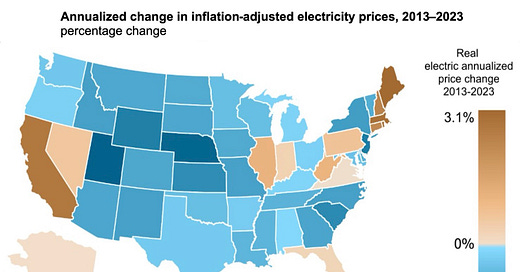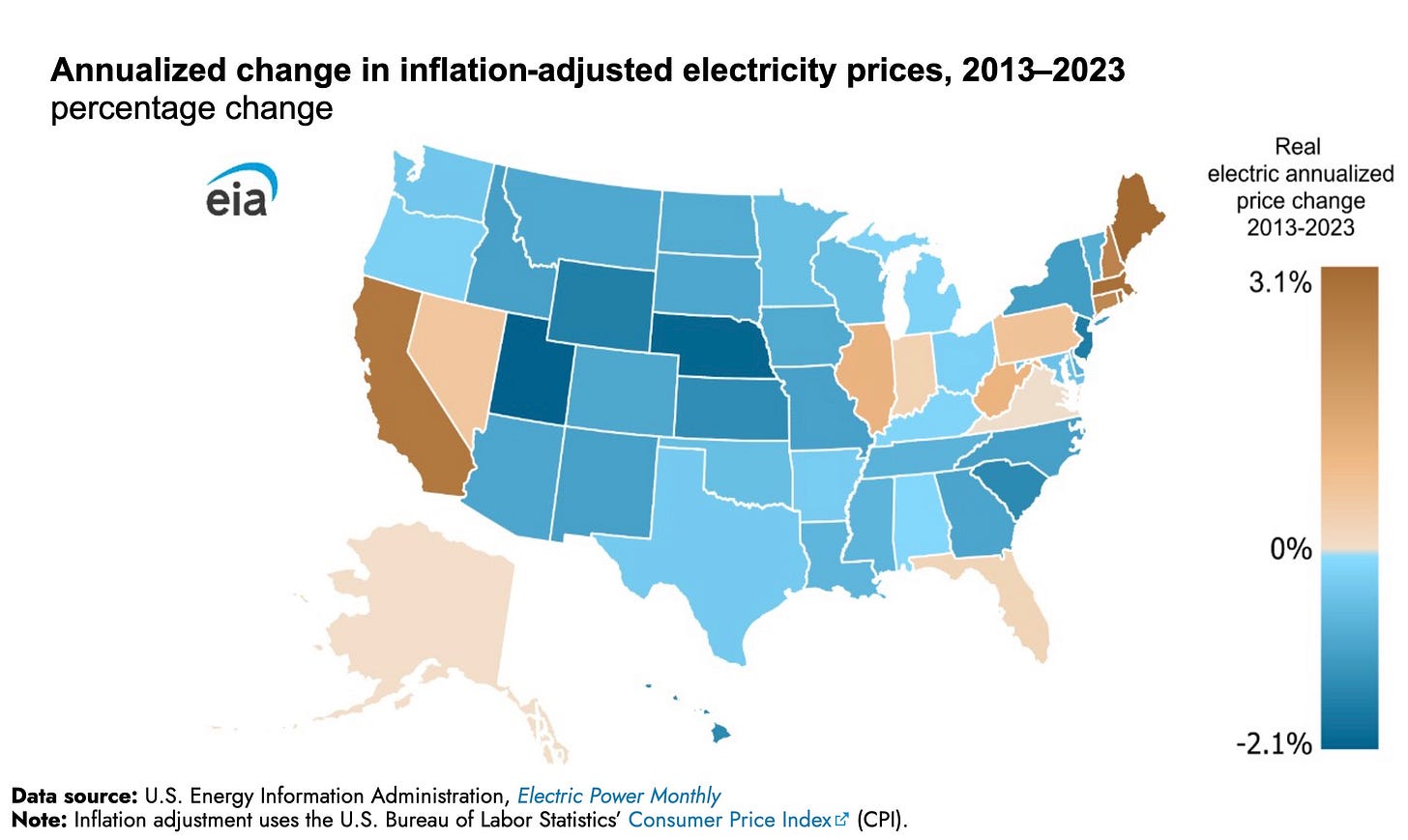California and New England: Two Politically Correct Regions with Economically Stupid Electricity Policies
Two months ago I put up a post here addressing whether or not RTOs (a/k/a “Independent System Operators” or “Transmission System Operators,” after more than two decades, had, in fact, increased the efficiency of our electrical grids. I suggested the answer was obviously not. The post got a lot of attention and stimulated a lot of discussion. RTO fans quibbled over details and RTO skeptics suggested I might well be correct. But, now there is additional support for the latter view and it comes from the Energy Information Administration (EIA).
Yes, the EIA, a week ago, posted this map on its Today In Energy website:
The map shows two areas of the country where electricity prices have escalated at a rate well above inflation (2% or more). One is California, and the other is New England. And, here are the reasons cited by EIA:
Prices tended to rise fastest in most of New England and in California, where real prices over the past decade increased by more than 2% on an annualized basis. Prices fell in the midcontinent, with the biggest drops in real prices occurring in Utah and Nebraska.
California’s real electricity price rose from a little over 21 cents per kWh in 2013 to almost 30 cents per kWh in 2023, an annual average increase of 2.8%. Higher costs and declining sales tended to increase average residential costs over this period. Costs included investments in grid modernization and renewable energy sources as well as increased operational and maintenance costs from wildfires and other natural disasters. California’s Renewable Portfolio Standard (RPS) mandates that a high percentage of energy must come from renewable sources such as solar and wind.
New England’s real electricity price rose from a little more than 21 cents per kWh in 2013 to the highest U.S. regional price of almost 29 cents per kWh in 2023, an annual average increase of 2.6%. The higher costs of natural gas and fuel oil starting in 2022 (major feedstock fuels for electricity generation in New England) were significant factors influencing the trend. New England has higher transportation costs for fuels due to competition for limited pipeline infrastructure into the region. In states that have deregulated their electricity markets (allowing consumers to select the energy portion of their electricity service) like most of New England (except Vermont), higher fuel prices directly contributed to the region’s elevated electricity retail prices. States in New England also have significant investment in RPS programs.
Over the past decade, the largest annualized real electricity price declines occurred in Utah (2.1%) and Nebraska (2.0%). Access to diverse and abundant local energy resources, including coal, natural gas, wind, and solar, helped keep price increases low despite growing demand for electricity. These states also benefit from well-developed transmission networks, excess capacity that can serve growing demand without the need for significant new investment, and relatively low population densities that limit the need for distribution upgrades.
Notice the following:
Utah is not part of a RTO.
Utah has a “well-developed transmission network” with no help from a RTO.
Both California and New England impose significant Renewable Portfolio Standard (RPS) mandates.
The only state in New England to keep electricity prices stable is Vermont, which also happens to be the only state in the region not to have deregulated electric pricing.
So, I read this news from EIA to largely support my thesis that RTOs do little or nothing to achieve their supposed mission of efficiently delivering electricity at reasonable prices to consumers. But, it also appears the states themselves are a huge part of the problem with their politically correct but economically wrong RPS mandates. Indeed, it seems every attempt to stupidly impose such mandates only represents a suicidal attack on energy security.
What say you, readers?
#RTO #Utah #California #NewEngland #EnergySecurity #ElectricPrices #EIA





Another excellent report on the self sabotaging of the American Electricity Grid. I have been preparing for a panel discussion on energy and electricity generation and have come to the conclusion that this winter is going to be very difficult for many areas of the U.S. In 2010 America had about 30% coal power generation capacity (about 315GW) Now, by self destructing over 122 GW of coal power generation capacity, while at the same time experiencing electricity growth, several RTO's are concerned for winter electric reliability. I wrote some of my thoughts and a bunch of references on my blog; The Coming Electricity Reliability Crisis and the Importance of Coal, Sept. 12, 2024: http://dickstormprobizblog.org/2024/09/12/the-electricity-reliability-crisis-and-the-importance-of-american-coal/
Also, "Inevitable Blackouts and Grid Reliability will Result from EPA Rules", WUWT, Sept. 18, 2024: https://wattsupwiththat.com/2024/09/18/inevitable-and-foreseeable-grid-operators-beg-court-to-nix-epa-rules-to-save-electricity-system-from-collapse/
Then, here is a recent post on the NY-ISO: https://dailycaller.com/2024/06/11/nyiso-grid-climate-pushing-new-york-blackouts/
To put it politely, America has Low Energy IQ people in charge of energy and electricity generation policies. They have been quoted as saying that "California is the Energy Model for the U.S.A." Yikes!
Here in California we have a blind government leading a blind government. All we can really hope for is that they will all fall down that deep well that they have dug, never to be seen again.
Can you even imagine how wonderful it would be to have a new government who would make California once again the Golden State where people want to move to, to enjoy what we really do have?